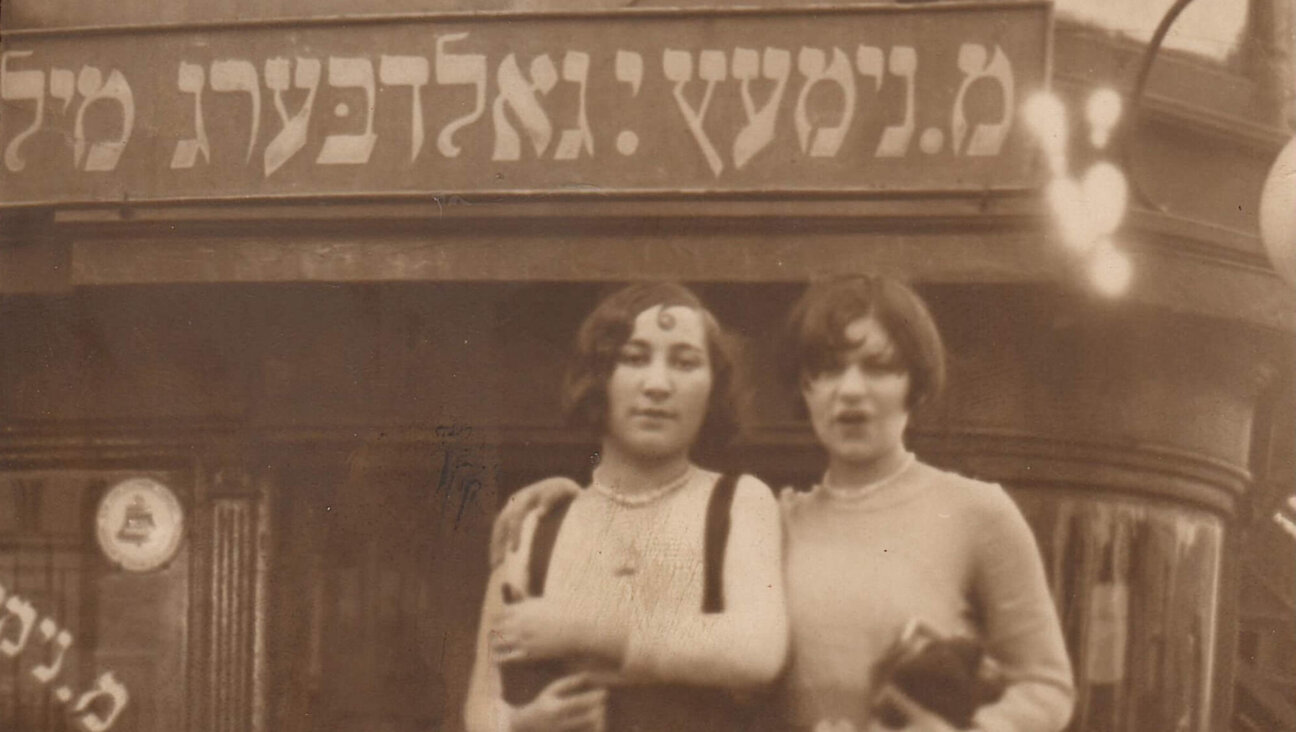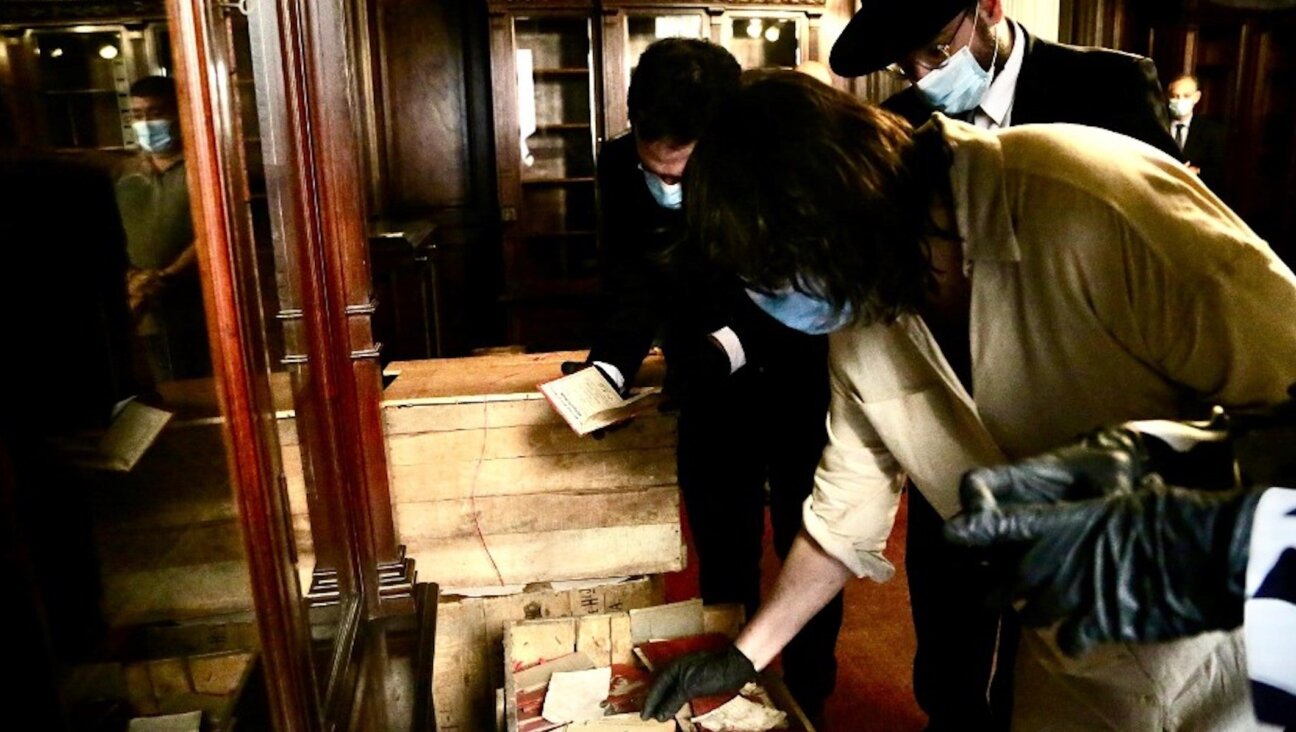Yiddish Folklore Inspires American Artist Debra Olin

Image by Lizzette Rodriguez
Read this article in Yiddish.
As seen in a new exhibit at the Museum at Eldridge Street, artist Debra Olin has created large format monoprint collages that explore Jewish folkloric superstitions and religious practices, particularly those of women in the Russian Pale of Settlement.
Olin based her art on the information she gleaned from an ethnographic questionnaire produced in eastern Europe before World War I to document every stage of Jewish life, beginning with rituals performed before a child’s birth and concluding with customs after a person’s death.
The Jewish Ethnographic Program, as this project was called, was launched by S. An-ski, the author of the Yiddish drama, “The Dybbuk”. An-ski was not only a gifted playwright, but also a scholar of ethnography and folklore who conducted several remarkable expeditions into the Jewish shtetls of Volhynia and Podolia from 1912 to 1914.
His goal was to document local Yiddish folklore and collect various artifacts such as menorahs, Torah coverings, etc. The questionnaire consisted of more than two thousand detailed questions that An-ski and his fellow researchers posed to their shtetl informants. Among them: “Is there a belief that one must not rock an empty cradle?” and “What medicines, precautions, and other means are used to have clever children?”
An-ski wasn’t an academic. His goal was to create a cultural bridge between the traditional Jewish inhabitants of the Pale of Settlement and the assimilated Jews of the Russian cities, particularly St. Petersburg. He hoped to persuade those Jews who had abandoned their Jewish cultural and religious identity to return to their spiritual roots as represented by the Jewish residents of shtetls, to the folk culture that he described as the “Oral Torah”. Eventually, An-ski hoped, a Jewish museum containing these artifacts would be built in St. Petersburg.
The devastating effects of World War I and the Russian Revolution destroyed An-ski’s dreams, however, and the Soviets confiscated his collection at the end of the 1920s. Today, these artifacts are dispersed among museums and archives in St. Petersburg, Kiev, and Minsk.
In 2011, University of California professor Nathaniel Deutsch translated the entire questionnaire into English with detailed notes. It was this book which inspired Olin to create original artworks based on the first chapter of the questionnaire, “The Child, from Conception to Cheder.”
Although the responses to the questionnaire that An-ski collected were never preserved, Olin doesn’t attempt to give her own answers through her art. On the contrary, she emphasizes the deep symbolic and mythical meaning embedded in these questions.

Debra Olin, “From the Oral Torah” Image by Lizzette Rodriguez
The exhibit, “Debra Olin: Every Protection”, consists of nine collages crafted by women’s clothing, that include texts taken from An-ski’s questionnaire. In a hanging installation called “From the Oral Torah”, visitors see four dresses with An-ski’s Yiddish questions draped over their shoulders hanging from the women’s balcony of the historic synagogue which houses the museum. The intention of her art, as Olin explains, is to “create a symbolic language to identify the beliefs, precautions and customs that people of all cultures could recognize, translate and empathize with.” As Professor Deutsch points out in his scholarly footnotes to An-ski’s program, many Jewish beliefs were similar to the folklore of the Slavic cultures among whom the Jews lived.

Debra Olin, “Every Protection”, monoprint collage Image by Bill Kipp
When Jews emigrated from Russia and Poland to America, they abandoned much of the folklore from the old country. Their supposedly old-fashioned beliefs and customs didn’t fit in with the modern American lifestyle. The immigrants preferred to conform their Jewishness to the dominant, more restrained Protestant standard and suppress the more emotive, “primitive” elements.

Debra Olin, “The Importance of Play 2”, Monoprint collage Image by Bill Kipp
As often happens in cultural history, appreciating a forgotten and rejected cultural legacy requires a certain distance. As a child of a generation born many years after the Jewish masses immigrated to America, Olin can look back at that culture with a fresh vision.
In the 1970s, there was renewed interest in An-ski’s personality and his accomplishments, both in the United States and in the Soviet Union. He became a cultural hero for a new generation of Yiddishists as someone who chose to return to his Jewish roots and to the Yiddish language after making a successful career among the “gentiles.”

Debra Olin, “T-shirt Totem”, monoprint collage. Image by Bill Kipp
In the Soviet Union, he was recognized among a small group of Jewish activists as a pioneer in the field of Jewish ethnography. After the fall of the Soviet Union, a new generation of Russian Jewish researchers began using An-ski’s questionnaire to do their own expeditions to former shtetls, in order to interview the aging and often last remaining Jewish residents there.
Olin’s artistic imagination has re-interpreted An-ski’s ethnographic questions into a unique symbolic language. This issue is dealt with in the very first questions of An-ski’s program which belong to the “story of creation” of the folkloric “Oral Torah”: “What beliefs are there about a person’s soul before it enters the body?” “At what moment is a soul considered to have entered the body of the fetus?” and “How does the soul enter the body?”
The collages in Olin’s exhibit serve as exquisite shells concealing a mysterious spiritual core.
“Debra Olin: Every Protection” will be on exhibit until April 2022.
A message from our Publisher & CEO Rachel Fishman Feddersen

I hope you appreciated this article. Before you go, I’d like to ask you to please support the Forward’s award-winning, nonprofit journalism during this critical time.
At a time when other newsrooms are closing or cutting back, the Forward has removed its paywall and invested additional resources to report on the ground from Israel and around the U.S. on the impact of the war, rising antisemitism and polarized discourse.
Readers like you make it all possible. Support our work by becoming a Forward Member and connect with our journalism and your community.
— Rachel Fishman Feddersen, Publisher and CEO























